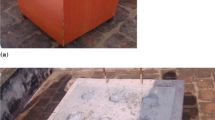Abstract
We analyzed of heat transmission across three roof structures ; bare RCC (reinforced cement concrete) roof, RCC roof with weathering coarse and RCC roof with PCM (phase change material) above RCC. A transient numerical procedure was developed. ANSYS-Fluent 12 finite volume method based software was used for solving the problem. The numerical procedure was validated against the available experimental data. The simulation was carried out on 365 days of the year for these three roofs. The PCM melted from 8 h to 18 h and solidified during the rest of the day. From March to August, the net heat entering into the room per day is positive, thus more and more PCM melts and becomes liquid. The liquid portion of PCM increases from March to August, during September to February, there is a net heat rejection per day, thus the melted PCM becomes solid progressively, and at the end of February, almost all PCM has become solid. Thus there is a melting cycle on a daily basis and over the year. It takes care of all the external climatic variations and keeps the roof bottom surface temperature almost constant and close to room air temperature. On yearly basis, about 56% reduction in heat transmission into the room is obtained with PCM roof when compared to the conventional weathering coarse laid roof.
Similar content being viewed by others
References
D. W. Hawes and D. Feldman, Absorption of phase change materials in concrete, Solar Energy Material and Solar Cells, 27 (1992) 91–101.
H. E. Feustel and C. Stetiu, Thermal performance of phase change wallboard for residential cooling application, Lawrence Berkeley National laboratory, Report LBL-38320 (1997).
A. K. Athienitis, C. Liu, D. Hawes, D. Banu and D. Feldman, Investigation of the thermal performance of a passive solar test-room with wall latent heat storage, Building and Environment, 32 (1997) 405–410.
M. Hadjieva, R. Stoykov and T. Filipova, Composite salthydrate concrete system for building energy storage, Renewable Energy, 19 (2000) 11–15.
T. Lee, D. W. Hawes, D. Banu and D. Feldman, Control aspects of latent heat storage and recovery in concrete, Solar Energy Material and Solar Cells, 62 (2000) 217–237.
D. Neeper, Thermal dynamics of wall board with latent heat storage, Solar Energy, 68 (2000) 393–403.
A. Sami and Al-Sanea, Thermal performance of building roof elements, Building and Environment, 37 (2002) 665–675.
R. Mehling, A. Krippner and Hauer, Research project on PCM in wood-light weight concrete, In Proceedings of the second workshop of IEA ECES IA Annex 17, Ljubljana, Slovenia (2002).
Y. P. Zhang, K. P. Lin, R. Yang, H. F. Di and Y. Jiang, Preparation, thermal performance and application of shapestabilized PCM in energy efficient buildings, Energy and Buildings, 38 (2006) 1262–1269.
Cabeza, Use of microencapsulated PCM in concrete walls for energy savings, Energy and Buildings, 39 (2007) 113–119.
P. W. Griffiths and P. C. Eames, Performance of chilled ceiling panels using phase change material slurries as the heat transport medium, Applied Thermal Engineering, 27 (2007) 1756–1760.
A. Pasupathy and R. Velraj, Effective of double layer phase change material in building roof for year round thermal management, Energy Building, 40 (2008) 193–203.
Author information
Authors and Affiliations
Corresponding author
Additional information
Recommended by Associate Editor Man-Yeong Ha
M. Ravikumar received his Bachelor’s degree in Mechanical Engineering from Coimbatore Institute of Technology, Coimbatore, Bharathiyar University, India. He received his Master’s in Energy Engineering from Regional Engineering College, Trichy, Bharathidasan University and obtained Ph.D. from Anna University during 2012. His areas of interest are Heat Transfer and Computational Fluid Dynamics.
PSS. Srinivasan obtained his B.E. Mechanical Engineering from Bharathiar University during 1988. He is a recipient of Gold medal from IITBombay at his M.Tech., during 1990. He obtained Ph.D. from Bharathiar University in 2002. His areas of interest are Heat and Mass Transfer, Computational Fluid Dynamics, Refrigeration and Air-conditioning, Waste Heat Recovery, Renewable Energy, Solar Passive Design of Buildings.
Rights and permissions
About this article
Cite this article
Srinivasan, P.S.S., Ravikumar, M. Heat transfer analysis in PCM-filled RCC roof for thermal management. J Mech Sci Technol 28, 1073–1078 (2014). https://doi.org/10.1007/s12206-013-1137-0
Received:
Revised:
Accepted:
Published:
Issue Date:
DOI: https://doi.org/10.1007/s12206-013-1137-0



